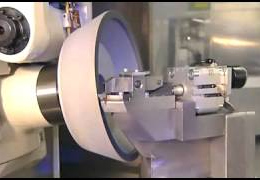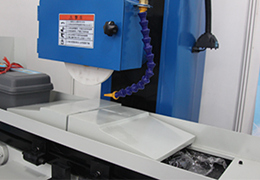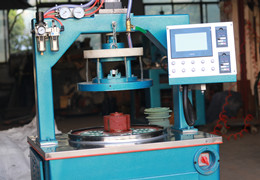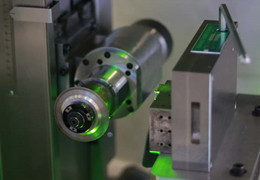Moresuperhard grinding solutions for Micro-precision machining
Ultra-precision grinding for higher productivity, lower cost, less rework and higher quality in hard and brittle materials and micro components.
There is still a huge gap between the research and application of ultra-precision machining technology in China and the world's advanced level due to the influence of basic equipment, process technology and the industry's foundation, and very little information is reported on this field. With an eye on the future potential of China's growing industry and a mission to help the Chinese manufacturing industry, DeburringTec will promote cutting-edge technologies, processes, products, equipment and services in the field of precision machining, geared towards innovative research and development, brand exchange and international cooperation.
Ultra-precision CNC machining/Ultra-precision machining - "High precision" in traditional machining refers to single-digit micron-level tolerances. Ultra-precision machining uses the cutting power of diamonds to produce tolerances to the "sub-micron" level through the use of miniature machine parts known as "nano-tools".
The technologies involved in ultra-precision CNC machining/ultraprecision machining are: micro cutting, micro EDM, laser cutting/etching/perforating, micro extrusion, micro embossing, micro stamping, micro injection moulding. Ultra-precision grinding is a subdivision of the micromachining process.
High-precision parts are increasingly used in optics, laser system components, medical technology and tool manufacture. Ultra-precision machining technology is essential for the successful production of high-precision optical and mechanical components in a wide variety of materials. Ultra-precision grinding enables the completion of parts with the highest form accuracy and final surface quality in the field of ultra-precision machining. This article will explain in detail the advantages and applications of this technology in the machining of hard and brittle materials and miniaturised parts.
1. What is ultra-precision grinding?
Ultra-precision grinding, also known as micro-grinding, is a precision manufacturing process used in various fields and is a grinding, honing or surface grinding process to obtain a specific surface shape by removing metal. Ultra-precision grinding is commonly used to achieve parallelism, perpendicularity, centering and contouring of hard and brittle materials and miniature parts, and is therefore often used as a final process.
Ultra-precision grinding is carried out on parts that are manufactured or machined by the end user and therefore accuracy is critical. Grinding cleans the surface, removes excess material, removes burrs, rounds edges, produces flat surfaces with parallel edges and finishes to tolerances very close to design standards.
A number of different ultra-precision grinding techniques can be used to obtain the desired results, and depending on the shape, size and texture of the part being machined, a number of different tools should be used, in accordance with the respective specification requirements.
2. Advantages of ultra-precision grinding
High precision
Ultra-precision grinding is a highly automated process designed to produce extremely precise shaping of highly complex parts, where tolerances are critical. It has a wide range of applications in aerospace, nuclear power plants, military equipment, medical equipment and manufacturing.
With the trend towards miniaturisation of hardware components, conventional point grinding methods are no longer sufficient to achieve high precision: tolerances in the nanometre range - in fact, 1,000 times smaller than a millimetre. Ultra-precision grinding automation combined with state-of-the-art vision systems provide automatic set-up and part positioning for each system to achieve high precision:
Machining technology for achieving nano-scale material removal
Machining of 3D structures with feature sizes from a few microns to several hundred microns
Ultra-precision grinding processes, sometimes referred to as profile grinding, can be applied to a wide range of hard and brittle materials, a variety of micro-components, and have been used to achieve precise dimensions inside precision parts. Precision grids help to produce mechanical parts that are precisely mounted in product chambers or cavities. The levels of precision and surface roughness generally achieved by ultra-precision grinding machines are as follows.
Dimensional accuracy ± 0.25 - 0.5 micron
Roundness 0.25-0.1 micron
Surface roughness 0.006-0.01 micron
Cost-effectiveness
Ultra-precision grinding is cost-effective and offers a competitive advantage that is important to the production process. Especially if you need a certain level of precision. For example, if you want to grind three concave surfaces on an object at the same time, this can easily be done with a precision grinding machine.
Ultra-precision grinding does not have the cyclical energy consumption of machining, making it cost-effective to run small and medium-sized batches for prototypes or short-term production runs.
Flexible and efficient
Ultra-precision grinding is a flexible and effective metal cutting process that produces smooth, flat and consistent finishes on advanced materials and a wide range of metals. Compared to turning with tools, ultra-precision grinding creates better surface quality, has higher cutting efficiency and can be highly versatile for those who need it.
High productivity and fast turnaround
It is increasingly common to see precision grinding technology, including ultra-precision grinding, as a necessary step in maximising productivity, with grinding machines running at high speeds, increasing the ability to produce large quantities of workpieces in a short time through a large number of revolutions. This facilitates the production of high quality parts at high speeds and reduces scrap rates. In addition, ultra-precision grinding is becoming a preferred practice because it eliminates secondary operations, thereby speeding up product turnaround times. In addition, ultra-precision grinding provides repeatable surface finishes, thereby increasing productivity.
Ease of monitoring and quality control
The difficulty of monitoring and quality control is one of the main challenges faced by many metal grinding companies. However, in ultra-precision grinding, wireless sensor measuring devices monitor roughness and cutting rates. The system also sends real-time data to a database, making it easy for the customer to check the status of production and make adjustments if necessary.
3. Types of ultra-precision grinding
The technician also selects the right tool to give the correct shape, size and texture to the surface of the workpiece to be polished. Depending on the size, shape, features and required productivity, the technician will select the appropriate grinding operation, classified as follows:
i.Flat grinding
Surface grinding is one of the finishing methods for flat surfaces, which results in better machining accuracy and surface quality. Surface grinding is usually carried out on a surface grinding machine. It can be done with the circumferential surface of the grinding wheel or with the end face of the grinding wheel.
When grinding the circumferential surface of the grinding wheel, the contact area between the grinding wheel and the workpiece is small, the heat generation is small, the cooling and chip removal conditions are good, and higher machining accuracy and smaller surface roughness values can be obtained, but the production efficiency is lower. When grinding with a grinding wheel endface, the grinding wheel has a large contact area with the workpiece, generates a lot of heat, and the cooling and chip removal conditions are poor, resulting in poor machining accuracy and surface roughness, but low and high production efficiency. In order to improve the grinding efficiency, multi-piece grinding is often used.
ii. Circular grinding
External cylindrical grinding, also known as centre grinding, is used to grind the cylindrical surface and shoulders of workpieces on the outer or inner diameter. External cylindrical grinding provides a smooth surface finish on round objects.
The workpiece is mounted in the centre and rotated by a device called a drive jaw or centre drive. The grinding wheel and workpiece are rotated at different speeds by different motors. The table can be adjusted to produce a taper.
Cylindrical grinding machines have a grinding wheel (wheel), two fixed workpiece centres and a chuck, grinding jaws or other mechanism to drive the workpiece. Most cylindrical grinding machines include a turntable to form tapered parts. The grinding wheel and workpiece move parallel to each other in the radial and longitudinal directions for dressing.
iii. Centreless grinding
Centreless grinding is usually used to machine long, thin, small workpieces that are not between the spindle and the tailstock. In this grinding operation, the workpiece is held between two rotating grinding wheels with high linear speeds, which perform the grinding action on the workpiece surface, and a guide wheel that drives the cylindrical workpiece on a variable spindle. The insert supports the workpiece during the machining process.
In a typical precision grinding process, the grinding wheel grinds the surface to the exact specifications of the project, while always maintaining the highest precision. However, in addition to this shaping and shaving, this grinding process produces a smooth surface with no bumps, dents or patterns.
4. What types of materials are suitable for ultra-precision grinding ?
Suitable for many hard and brittle materials such as ceramics, tungsten carbide, non-ferrous metals, steel, plastics and glass with extremely high wear and temperature resistance, high hardness and low fracture toughness. Due to these properties, the materials can only be machined by cutting operations using cutting edges with undefined geometry.
Ultra-precision grinding processes are essential for the production of parts with high-precision surfaces on hard and brittle substrates. State-of-the-art machines are often configured for ultra-precision grinding and ultra-precision turning using single crystal diamond tools, including ultrasonic-assisted diamond turning. Capable of working with a wide range of metals, plastics, composites and special materials, including
Alloy steels/high hard metals/carbide/Aluminium/brass/Bronze alloys /quartz/Precision ceramics
Carbon steel/Iron/Magnesium/Stainless steel/Titanium/ABS/Glass fibre reinforced plastic/Polycarbonate/PVC/Polytetrafluoroethylene
The manufacturing process is capable of producing a wide range of geometries, including rotationally and non-rotationally symmetrical parts such as spheres, aspheres, free-form surfaces and structured surfaces. Using dedicated ultra-precision machines and air bearing spindles in combination with suitable process strategies, shape accuracy of PV < 250 nm and surface roughness of Ra < 5 nm can be achieved.
5. What types of parts are suitable for ultra-precision grinding ?
Ultra-precision grinding is mainly used for the production of high-quality and functional micro-components made of materials that are normally hard and difficult to machine (e.g. components in many modern electronic devices that require precision grinding), such as for the manufacture of magnetic heads, optical glass, electronics, moulds, bearing gears, cranks, cams and precision components with miniature structures (micro-gears of 50 µm) that require a high degree of flatness, a high degree of parallelism or an excellent surface finish.
However, there are also many larger parts that also require precision grinding, including parts commonly used in aerospace instruments, medical equipment, blade tools, and many different scientific instruments for mobile car details in La Jolla. These devices are very sensitive and allow for very small tolerances, so every grind needs to be absolutely regulated. Most precision grinding projects can be adapted to the precise specifications of a wide variety of different parts.
There are, of course, many alternatives to precision grinding which can also be used to meet the needs of the above applications, but these are often not cost effective or accurate.
In summary, ultra-precision grinding can bring benefits throughout the production cycle. The result is higher productivity, lower costs, less rework, higher quality parts and tools, higher customer satisfaction and more flexible scheduling.




